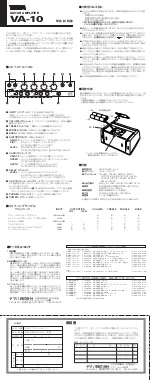
PC-505B Manual, Rev. 201013
Warner
Instruments
A Harvard Apparatus Company
28
To establish a
zero baseline reference potential
, activate the junction zero circuit by
placing the
AUTO
-
ZERO
toggle switch into the
on
position. This turns the auto-zero LED
on.
Next,
depress and hold
the
AUTO
-
ZERO PUSHBUTTON
to activate the automatic correction
circuit. The settling time is rapid when used with M
pipette resistances, but can take
several seconds if used with G
resistances. For complete compensation, keep the
pushbutton depressed until I
m
on the
METER
reads
zero
. If needed, small corrections to the
offset can be made by adjusting the
JUNCTION ZERO
control.
Releasing the
AUTO
-
ZERO PUSHBUTTON
locks the offset potential to the value set during
this operation. The value will remain in effect until the toggle is switched
off
or the
pushbutton is
re-depressed
. Switching the
AUTO
-
ZERO
toggle to
off
restores the
uncompensated current and voltage.
NOTE:
Applied holding potentials remain active when the
AUTO
-
ZERO
toggle is turned
on
.
Depressing the
AUTO
-
ZERO PUSHBUTTON
, however, zeros all manual settings (including holding
potential, time-averaged test pulse, or command voltage) during the zeroing function.
Manual settings are re-applied when the
PUSHBUTTON
is released.
After zeroing the current, the magnitude of the junction potential can be read from the
meter (
V
c
+h
setting) or on the oscilloscope from the V
c
x10 output. The zero baseline setting
should remain stable so long as the
AUTO
-
ZERO TOGGLE
switch is set to
on
. If the value drifts,
then make sure the reference electrode is properly submerged. If the zero setting continues
to drift, then check your setup for errors (e.g., chloriding of the electrodes).
IMPORTANT!
Once set, do not make further adjustments to the zero setting until you take a
new pipette. If you change the zero setting after forming a gigaseal, then you
’
ll not know the
true transmembrane potential!
Measure the pipette resistance (RP)
Measuring the resistance of the pipette is a routine method for determining the pipette's
condition before attempting to record data. Useful pipettes for patch recording can have
resistances within the range of 1-10 M
and those for whole cell recording can range from
1-5 M
. The specific resistance you
’
ll see is highly dependent on the solutions used and the
size of the tip. Generally speaking, smaller tips have higher resistance, more easily make
gigaseals, and are desired for patch work. Larger tips are better for whole cell work since it
is easier to rupture the membrane and the access resistance will be lower.
Pipettes with much higher resistance are likely to be blocked with debris from poorly
filtered pipette or bath solutions, or to have constricted tips from over-polishing. Those with
much lower resistance are probably broken. In either case, take a new pipette and start over.
The pipette resistance is measured with the pipette in the bath and a
TEST PULSE
applied.
A test pulse function can be driven from software (e.g., pClamp, PatchMaster) or from the
amplifier. In the amplifier, the test pulse is activated by setting the
COMMAND SELECT
toggle
to
internal command
, the
SENSITIVITY SELECTOR
toggle to
x0.001,
and the
COMMAND SENSITIVITY
toggle
to
on
. These settings activate and apply a line frequency, 1 mV peak-to-peak square
















































